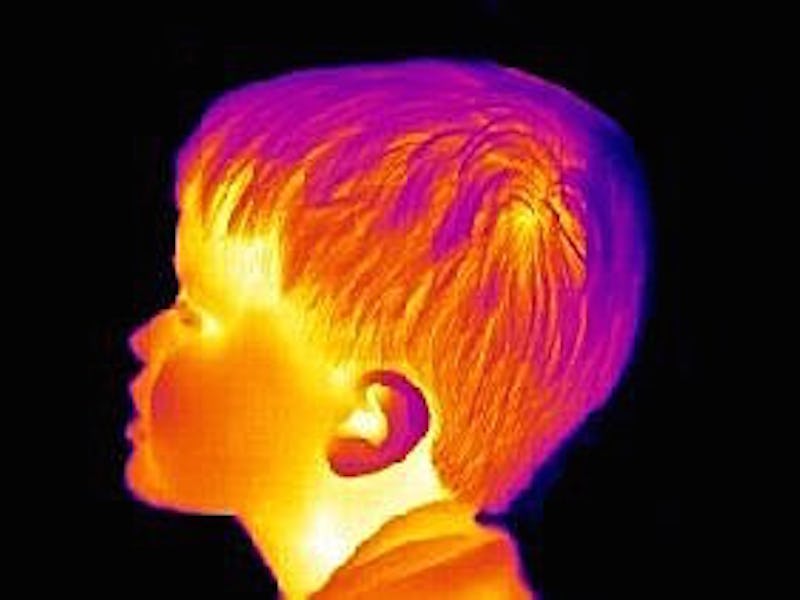Fevers Linked to Evolution of Warm-Blooded Animals in Weird New Theory
"High, stable body temperatures prime the immune system."

Warm-blooded animals like mammals and birds spend a ton of energy simply keeping their bodies warm enough to live. Meanwhile, reptiles and other cold-blooded creatures soak up heat by lounging in the sun, saving lots of energy in the meantime. This should make them role models for us, as they require much less food to stay alive. But in a new paper published Tuesday in Ideas in Ecology and Evolution, one scientist presents a new explanation for our inefficiency: Being warm-blooded arose in mammals because it allows us to have fevers.
In the paper, Michael Logan, Ph.D., proposes a new hypothesis about the huge role that illness-causing microorganisms played in the evolution of some of our earliest ancestors. Since fever is a key weapon in the body’s response against infection — the body turns up its temperature to help immune cells kick into action — Logan argues that warm-blooded animals are at an evolutionary advantage because they can produce heat on their own. Rather than having to climb up onto a sunny rock, exposing oneself to potential predators and wasting time that could be spent mating, the mammalian body can get feverish all on its own.
The ability to get a fever might sound like a pretty crappy skill, sort of like a superhero who whose only power is shooting firecrackers, but when it comes to surviving illness, argues Logan, it’s crucial.
Ectotherms like iguanas get their warmth from their environment, rather from their metabolism, but they may not be as resistant to pathogens.
“Growing evidence suggest that fever decreases the fitness of the pathogen indirectly by increasing the efficacy of the host’s immune system,” writes Logan, a research fellow at the Smithsonian Tropical Research Institute. “Although in certain cases fever-range temperatures do directly impact the fitness of pathogens, it now appears that the major role of fever is to push the organism to their thermal optimum for immune function by acting on the fundamental thermodynamic requirements of immune system components.”
This fact, that fever helps fight off infections, seems to hold true whether an animal is an endotherm (warm-blooded) or an ectotherm (cold-blooded). For ectotherms, fighting off an infection usually involves what’s called behavioral fever. This means that instead of just getting hot like we do when we’re sick, they seek out warmth in their environment to help fight off the infection. The natural world is a cruel place, though, so seeking a warm place to soak up the sun may come with dangers. For instance, a lizard sitting out on a rock becomes tempting prey for a bird.
So when it comes to natural selection, it would make sense that evolution would favor animals that can get fevers all on their own, rather than having to engage in behavioral fever. After all, natural selection just means that the individuals who have the most favorable set of traits for survival will pass them on to their offspring.
“My hypothesis is that endothermy is favored by pathogens because high, stable body temperatures prime the immune system for a rapid, effective response to infection,” Logan writes.
Next time you're home sick, just be grateful that your immune system can get warm all on its own.
He suspects that the exact way that endothermy arose in the earliest warm-blooded creatures must have been something of an evolutionary arms race. In this proposed scenario, a population of ectotherms must have faced either a particularly virulent disease threat, conditions that made it especially unsafe for them to regulate their temperature behaviorally, or both.
In this process, as in other cases of natural selection, the individuals with slightly warmer body temperatures eventually won out over the others because they fought off infections more successfully, didn’t get killed while trying to catch some rays, or both. Eventually, these animals evolved to be the mammals and birds that live on Earth today.
If true, this hypothesis helps explain why warm-blooded animals would make such a puzzling energetic tradeoff, expending many times the energy of ectotherms just to stay alive. Of course, evolution doesn’t have freewill. It arises out of a combination of mutations and environmental forces that eventually result in unique species with unique characteristics.
Regardless of how it arose, the simple fact is that warm-blooded animals are pretty lucky that they’ve got such an effective system for fighting off infections. So next time you’re sick with a fever, lying in bed rewatching an entire season of an old TV show, just be grateful that you don’t have to climb onto the roof to get warm.
Abstract: The evolutionary success of endothermy in mammals and birds represents an enduring enigma. Relative to an ectotherm of equivalent body size, endotherms expend many times the energy to maintain high, stable body temperatures. What source or sources of selection could have favored such an energetically costly strategy? Several hypotheses have been proposed for agents of selection that may have facilitated the rise of endothermy, with mixed support for each. Here, I discuss the possibility that an additional agent of selection, pathogens, may have played an important role in the evolution and maintenance of obligate endothermy in mammals and birds. I draw on recent work demonstrating that the immune system is highly thermally sensitive and individuals that maintain warm body temperatures have enhanced ability to reduce pathogen burdens. To further increase immune function when encountering a pathogen, ectotherms often employ the environmentally constrained and costly strategy of behavioral fever, whereas endotherms maintain body temperatures close to the optimum for immune performance at most times, essentially ‘priming’ their immune systems for a rapid response to infection. An evolutionary arms race in an ancient ectotherm, in which better behavioral thermoregulators were favored by increasingly virulent pathogens (and vice versa) could have contributed to the evolution of obligate endothermy in mammals and birds.